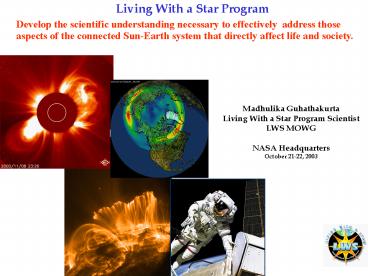Madhulika Guhathakurta - PowerPoint PPT Presentation
1 / 11
Title:
Madhulika Guhathakurta
Description:
Develop the scientific understanding necessary to effectively address those aspects of the connected Sun-Earth system that directly affect life and society. – PowerPoint PPT presentation
Number of Views:70
Avg rating:3.0/5.0
Title: Madhulika Guhathakurta
1
Living With a Star Program
Develop the scientific understanding necessary to
effectively address those aspects of the
connected Sun-Earth system that directly affect
life and society.
Madhulika Guhathakurta Living With a Star
Program Scientist LWS MOWG NASA
Headquarters October 21-22, 2003
2
Presidents Vision Goals
- Implement a sustained and affordable human and
robotic program to explore the solar system and
beyond - Extend human presence across the solar system,
starting with human return to the Moon by the
year 2020, in preparation for human exploration
of Mars and other destinations - Develop the innovative technologies, knowledge,
and infrastructure both to explore and support
decisions about the destinations for human
exploration - Promote international and commercial
participation in exploration to further U.S.
scientific, security, and economic interests
3
Sun-Solar System Connection
Planet
Varying Radiation Solar
Wind Energetic Particles Driven by 11 Year
Solar Cycle
Variable Star
Solar Flares
Geomagnetic Storms
Year
98 00 02 04 06
08 10 12 14 16
18
- How and why does the Sun vary?
- How does the Earth and Planets respond?
- What are the impacts on life and society?
4
(No Transcript)
5
(No Transcript)
6
Science Application as the Focus
- The primary goal of the LWS Program is to develop
the understanding necessary to enable the U.S. to
effectively address those aspects of the
Connected Sun-Earth system that directly affect
life and society. - Space Weather
- Sun-Climate Connection
7
LWS is a Systems Approach
LWS focuses not on any one region of space, but
rather on our Sun Earth Region as one system.
A very important part is the study of the
connection between the regions and how one drives
a response in another.
8
LWS-Related Missions
SDO
SOHO
TRACE
SOLAR-B
ACRIMSAT/SORCE
SOLAR
CORONAS-F
CORONAS-PHOTON
RHESSI
PICARD
SST
ULYSSES
WIND
ACE
STEREO
SMEI
L5
SOLAR ORBITER
HELIOSPHERIC
INTERHELIOPROBE
SOLAR SENTINELS
GEOSTORM
MESSENGER
BEPPI-COLUMBO
GEOTAIL
INTERBALL/PROGNOZ
SAMPEX
POLAR
RAVENS
FAST
IMAGE
MAGNETOSPHERIC
TWINS
FUV IMAGER
CLUSTER
MMS
RBSP
DOUBLE STAR
THEMIS
SWISE-1
LANL/GOES
TIMED
SWARM
C/NOFS
I-TSP
AIM
COSMIC
ROCSAT-2
EPOP
IONOSPHERIC
EQUARS
INDEX
VULKAN
DMSP/POES
NPOESS
GPS
Solar Max
Solar Max
Solar Max
92 94 96 98
00 02 04 06 08
10 12 14 16 18
Year
8
9
LWS Exploration (Geospace)
- Radiation effects will be a significant part of
any space exploration program. There are three
main areas where I see LWS geospace might
contribute - Manned space flight
- The biggest risk is in interplanetary space (or
Lunar surface) from SEPs (Solar energetic
particles) - There is also significant risk from the
terrestrial radiation belts (and south atlantic
anomaly if travel to the moon or Mars is staged
and starts with a stay in LEO (e.g. at the
international space station or similar facility) - Planetary exploration
- If we want to understand the radiation
environments at other planets and - predict the potential effects there then we need
to use the Earths radiation belts as a local
laboratory. Among the questions are - What do we expect at other planets?
- How do we scale what we observe if we dont
understand the dynamics - Space Infrastructure
- Understanding the impacts of the Earths
radiation environment on space infrastructure
will be increasingly important as mankind moves
even more aggressively into space. - Space infrastructure will have to increase and
will be vulnerable to radiation belt effects - Space exploration is not completely uncoupled
from the increasing DOD programs in Military
Space, Space Control, and Space Situational
Awareness. LWS geospace has increasing relevance
to those increasingly important national
programs.
10
LWS Exploration
- 1. Identify the broad space weather needs of
NASA Exploration Vision, especially for the
future directions our Agency will be taking. This
includes technology development, scientific
research and understanding, and the concerns
regarding the effect of space weather phenomena
on a long-term human presence in space. - 2. Identify the assets, programs, and
development efforts that NASA has or has access
to, now and in the future, which can be used to
further our ability to understand space weather
and its effects on Exploration.
11
LWS Exploration (cont.)
- 1) Near-term e.g. assets which can be readily
adapted to fit more of NASA's space weather
needs. Missions currently taking measurements
(SOHO, ACE, Ulysses), missions which can be
mobilized for space weather usage with minimal
effort (Cassini and other planetary programs),
models which can be easily implemented, and
modifying observing and reporting structures to
suit the broader needs of NASA. - 2) Intermediate term e.g. focus on technology
development, such as radiation-hard components,
which will allow us more independence and
reliability in space focus on gathering more
information regarding the exposure and effects of
exposure of various types of radiation on
humans. - 3) Long-term e.g. identifying current plans
and roadmaps which can be synergized to better
suit NASA's needs.































